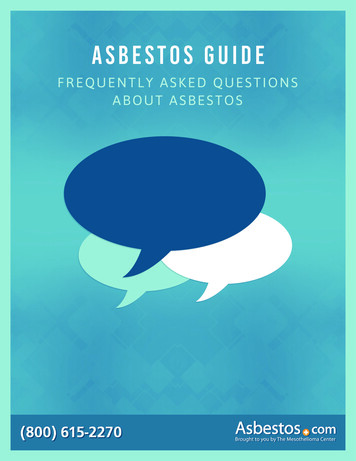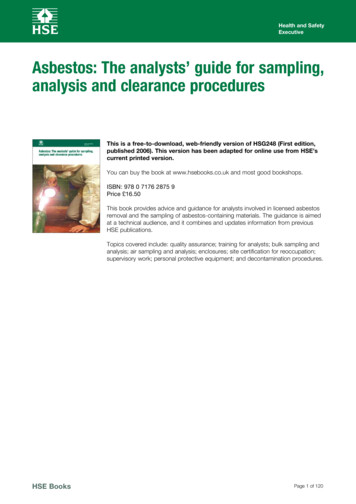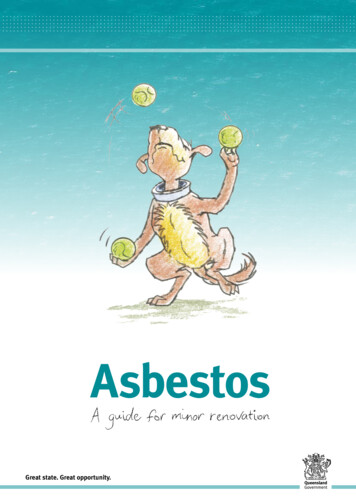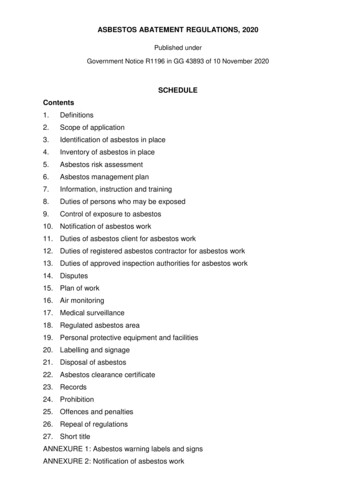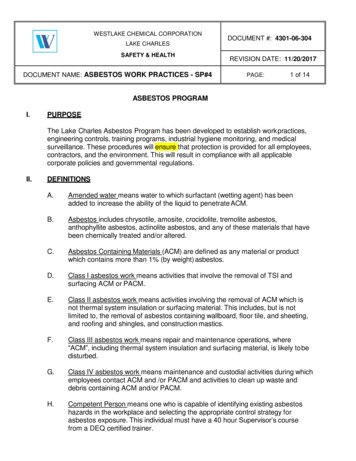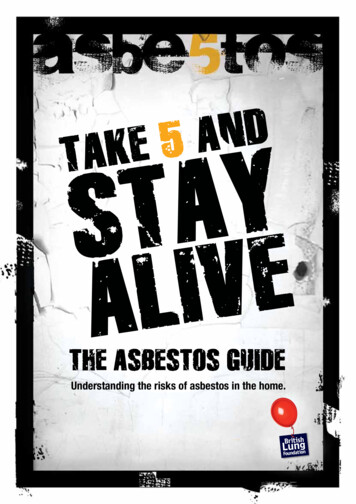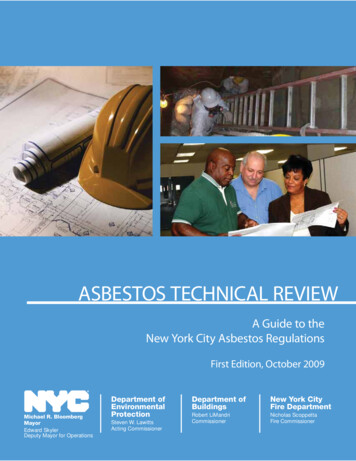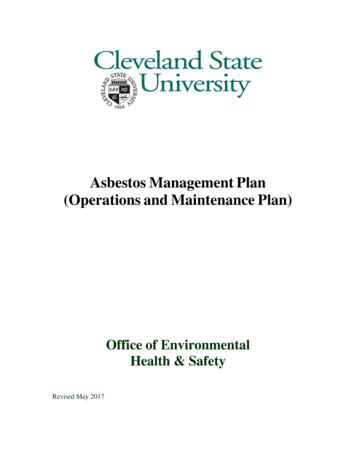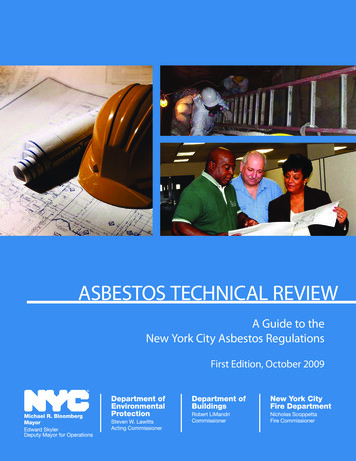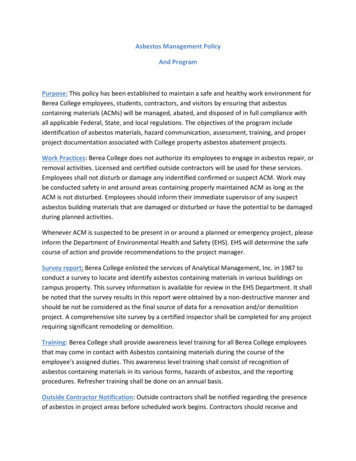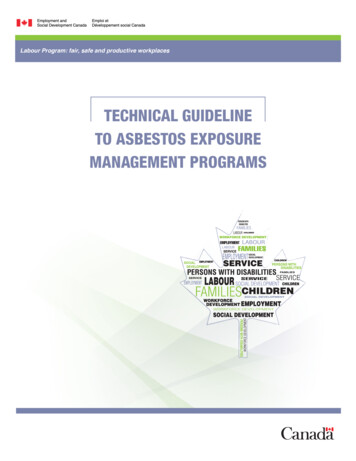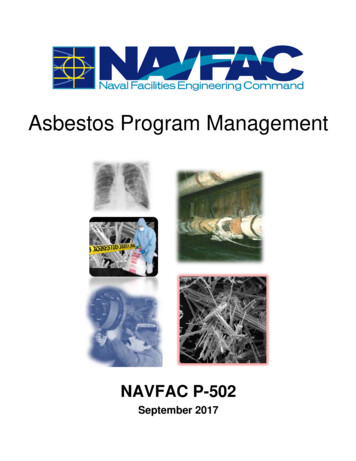
Transcription
Asbestos Program ManagementNAVFAC P-502September 2017
The P-502 is available in the document library section of the NAVFAC Portal.Please direct questions, comments, and/or recommended changes to the P-502 to:Naval Facilities Engineering CommandPublic Works Business Line1322 Patterson Ave SE, Suite 1000Washington Navy Yard, DC 20374-5065(202) 685-9232
CHANGE RECORDThis page is provided for recording of future changes to this version of P-502Change No.Title or BriefDescriptionDateiiEntered By
Table of Contents1General Overview 11.1 Introduction 11.2 Purpose and Scope 31.3 Safety Commitment 31.4 Asbestos Containing Material (ACM) 31.4.11.4.21.51.62Asbestos Hazards 5Regulatory and Policy Overview 6Program Resourcing and Technical Governance 92.1 Program Resourcing 92.2 Program Technical Governance 92.3 Environmental Management System 102.4 Other Environmental Liabilities 102.5 Tools 102.5.12.5.22.5.32.5.42.5.52.5.62.5.72.5.83Health Concerns Associated with Asbestos Exposure 4Means of Exposure 4NAVFAC Portal 11iNFADS 11Maximo 11GeoReadiness 11Enterprise Safety Application Management System (ESAMS) 11Environmental Portal (EPR) 11ECATTS 11WBDG 112.62.7Emergency Response/Fiber Release Episodes 11Performance Reviews 132.82.92.10Internal Audits 13Environmental External Audits 13Public Works Readiness Evaluation Process 13Roles and Responsibilities 143.1 Public Works Business Line 143.1.1Public Works Business Line Leader Echelon II 153.1.2Public Works Business Line, Facilities Management & Sustainment (FM&S) Product Line(PL): Echelon II and III NAVFAC Atlantic (LANT) and NAVFAC Pacific (PAC) 153.1.3FM&S PL: Echelon IV (Product Line Coordinator [PLC]) 153.1.4Facilities Management Division 163.1.5Production Division 163.1.6UEM Product Line 173.23.2.13.2.23.2.33.33.3.13.3.23.43.4.1Capital Improvements Business Line 17Echelon II, III 17Echelon IV (Core & IPTs) 17Echelon IV PWD/Facilities Engineering and Acquisition Division 17Environmental Business Line 18Echelon II, III 19Echelon IV (PWD/Environmental Division) 19Asset Management Business Line 20Echelon II, III 20iii
Echelon IV (Core & IPTs) 20Echelon IV PWD/Facilities Management Division 203.4.23.4.33.5Safety Support Line 21Echelon II, III & IV 21PWD Site Safety Managers 213.5.13.5.23.6Operations Department Support Line 21Public Works Officer (PWO) 22Deputy PWOs (DPWO) / Assistant Public Works Officers (APWO) 223.6.13.6.23.73.83.93.103.113.123.13Business Director (BD) Support LineInspector General Support LineAcquisition Support LineCommand Information Office Support LineOffice of Counsel Support LineNAVFAC Engineering and Expeditionary Warfare CenterNon-NAVFAC Entities24242424252525BUMED 25Naval Safety Center 25DoDEA 26Tenant Commands 263.13.13.13.23.13.33.13.43.14 Asbestos Stakeholders 3.14.93.14.103.14.114Roles and Responsibilities of the Asbestos Program Managers 314.1 PWD Asbestos Program Manager 314.1.14.1.24.1.34.1.44.24.2.14.2.25PWD Production Shops 26Base Operation and Support Contractors 26In-House Sampling and Abatement Teams 27Requirements Branch 28Contractors 28FEAD/Capital Improvements Business Line 28Real Property Accountable Officer (RPAO) 28Environmental Business Line 28Transportation Product Line 29Safety 29BUMED 30Appointment Letter 33APM Task List 33Legal Liability 39Work Management 40FEC FM&S Responsibilities 40Product Line Coordinator 40Core Asbestos Program Coordinator 41Training 435.1 Training Requirements 435.1.15.1.25.1.35.25.2.15.2.25.35.4OSHA Work Classes 46AHERA MAP Required Training 47Training Summary 47Resourcing 48Funding 48Approvals and Tracking 48NAVFAC Provided APM Awareness Training 48Training Providers 48iv
5.4.15.4.25.4.35.4.46Asbestos Inventories 526.1 Types of Asbestos Surveys 546.2 Resourcing 556.3 Planning Asbestos Surveys 566.3.16.3.26.3.36.3.46.3.56.46.4.17ESAMS 48Naval Safety Center 49Outside Vendors 49ECATTS 49Components of an Asbestos Survey 56Baseline Surveys 57Potential Buildings Not Requiring Asbestos Surveys 58MEP/MAP/LRMP Coordination 59Periodic Surveillance 59Building Inventory Data 60Existing Surveys 60Worker Protection 617.1 Building Occupants uilding Monitor Program 61Building Occupant Awareness 61Worker Protection 62Medical Surveillance Program 62Respirator Protection Program 63Personal Protective Equipment 66In-house abatement shops 66Class III Production Work 66Job Site Controls 67NESHAP Requirements 68DOT Hazardous Material Rules 688Project Evaluation 698.1 Work Induction Process 698.2 MILCON and Special Projects 708.3 Regulatory Notifications 708.4 Self-Help 709Emergency/Urgent/Routine Work Evaluation 719.1 Asbestos Hazards Associated with E/U/R Work 719.2 Evaluation of Potential Asbestos Impacts Within E/U/R Work Flow 719.3 Production Shop AND BOSC E/U/R Business Processes 7210 Abatement 7310.1 Abatement Plan Review and Approval 7310.2 Asbestos Abatement Workers 7310.3 Medical Monitoring 7410.4 APM Site Visits 7510.5 Third Party Monitoring and site clearance Monitoring 7510.5.110.5.210.5.3Initial Exposure Assessment 76Negative Exposure Assessment 77Air Monitoring During Asbestos Work Activities 7710.6 Updating Asbestos Inventory 7910.7 Types of Asbestos Work 79v
10.7.110.7.210.7.310.7.4OSHA Class I 79OSHA Class II 83OSHA Class III 87OSHA Class IV 8710.8 Notifications 8811 Waste Management 9111.1 Packaging and Labeling 9111.2 Asbestos Waste Handling, Storage, and Transportation 9411.3 Disposal Requirements 9611.4 Record keeping 9712 Record keeping and Management 9912.1 Types of Data and Records 9912.2 iNFADS 9912.3 ESAMS 9912.4 EPR Portal 9912.5 Audits and regulatory inspections 100Sample List of Suspect Asbestos Containing Materials 2TablesTable 1 ‐ Ban Status for Asbestos Containing Materials 5Table 2 ‐ Asbestos Containing Materials NOT Banned 6Table 3 – Asbestos Program Primary and Supporting Responsibilities Summary Matrix 22Table 4 – PWD APM Responsibilities and Tasks 34Table 5 ‐ FEC Indoor Air Quality / Asbestos Program Manager Tasks 42Table 6 – Training Requirements 45Table 7 – Asbestos Training Summary 50Table 8 ‐ Summary of Regulations Requiring Performance of Building Surveys 54Table 9 ‐ OSHA‐Assigned Protection Factor Values for Respirators 65Table 10 ‐ OSHA Medical Surveillance Requirements for Asbestos Workers 74Table 11 ‐ Summary of Federal NESHAP Abatement Notification Requirements 88AppendixesAppendix A – Site Specific RegulationsAppendix B – Compliance MatrixAppendix C – Regulatory Agency Site Visit TrackingAppendix D – Example APM Appointment LetterAppendix E – Accidental Asbestos Fiber Release Episode TrackingAppendix F – PWD/FEC Training PlanAppendix G ‐ Baseline Survey Prioritization CriteriaAppendix H ‐ Asbestos Free CertificationAppendix I – Asbestos Abatement Plan ChecklistAppendix J – Asbestos Safety AwarenessAppendix K – Example Asbestos Waste Shipment RecordAppendix L – Example ICAP Coordinated Periodic SurveillanceAppendix M – Example Building Occupant Notification Lettervi
1 General Overview1.1IntroductionThis manual provides the Naval Facilities Engineering Command (NAVFAC) and installationAsbestos Program Managers (APMs) a consolidated and centralized source of asbestosinformation and guidance to be applied to shore facilities and personnel. The goal of this manualis to provide guidance to installation APMs for implementing standard asbestos program actionsto prevent the release of asbestos fibers during maintenance, renovation, or demolitionactivities.APMs are:Assigned in writing by their Commanding Officer (or By direction)Trained per paragraph 5.1.2 below (AHERA MAP Required Training)Survey their realm for asbestos containing material (ACM)Record type, location and disposition of ACM (per criteria provided herein)This publication cancels and replaces the following NAVFAC publications: Asbestos Inspection/Reinspection Decision Tree NFESC Technical Memorandum (TM2325-ENV) Asbestos Control Program Operations and Maintenance Plan Special Publication (SP2027-ENV) Facilities Management Guide for Asbestos and Lead Technical Report (TR-2254)asbestos portions onlyThe NAVFAC Asbestos Management Program is managed by the Public Works Business Line(PWBL), Facilities Management and Sustainment (FM&S) Product Line (PL). The authoritativeelectronic version of this manual (and electronic versions of appendices and forms) is on theNAVFAC PW, FM&S Asbestos web portal.The manual contents and procedures fulfill the requirements of Chief of Naval OperationsInstruction (OPNAVINST) 5100.23 asbestos management program ashore key elements(Operations and Maintenance [O&M] program, Survey and Material Assessment, and Designand Abatement). With this NAVFAC-wide approach, Public Works Department (PWD) orinstallation site-specific asbestos instructions, asbestos management plans, and asbestos O&Mplans need to only be developed for site specific conditions which can be documented inAppendix A.Additional guidance and reference documents are provided herein, through previouspublications, and on the NAVFAC portal.This manual is organized and procedures are designed to be integrated into current NAVFACperformance and execution of facilities maintenance and sustainment work, thereby fulfilling theelements of an Operations and Maintenance (O&M) work control permit system. Included is adescription of how authoritative systems, including the Internet Naval Facilities Asset Data Store(iNFADS) and Maximo, are used to manage asbestos data and to guide the decision makingprocess as it relates to asbestos management. Also included are a description of the PWD workflow process and a discussion of how APMs should insert themselves into each step of thatprocess.The objective of this manual is to assist APMs in the management of the asbestos program attheir installation. The manual focuses on nine asbestos program elements that are essential formanaging asbestos at installations, regardless of size, geographic location, or complexity:1
1. Staffing and Program Management2. Training and Experience3. Asbestos Inventories and Baseline Surveys4. Worker/Occupant Protection5. Project Work Type Evaluations (i.e. Planned/Scheduled Maintenance Activities –including Preventive Maintenance Plans and in-the-field Infrastructure ConditionAssessment Program (ICAP) assessments)6. Emergency/Urgent/Routine (E/U/R) Work Type Evaluations (i.e.Unplanned/Unscheduled Maintenance Activities)7. Abatement8. Waste Management9. Recordkeeping and Data ManagementThe manual presents the procedures for day-to-day management of asbestos at installations.The manual will help APMs to: Maintain compliance with Navy policies, federal and state regulations, and localgovernment asbestos requirements Maintain life cycle asbestos building records and inventories Implement and follow the NAVFAC Public Works O&M program, including the workcontrol permit system Abate ACM Support the Environmental (EV) Business Line in the handling of ACM waste Develop an asbestos emergency response system Train staff Create and maintain necessary recordsEach of the sections herein outline the minimum required standing operating procedures ordocumentation that must be developed and implemented at PWDs. The appendices provideexamples/templates for procedures, forms, or references that can be used to develop sitespecific items. The APM can make additional recommendations for site specific procedures orforms for the PWD, but they must be approved at FEC level. Documentation is to bemaintained by the APM regarding these local decisions.The status of PWD level program implementation will be reviewed and measured by the FEC.Reviews will be based on the effectiveness of documentation of program element requirementsand processes.Appendix A incorporates the requirements of OPNAVINST 5100.23 and when so annotatedand augmented by installation documentation, coupled with this P502, will serve as theinstallation’s Asbestos Operations and Maintenance Program. As circumstances change overtime Appendix A must be so revised. In addition, Appendix A contains a summary of local-levelregulations and guidance documents as they serve the needs of the installation. APMs shallretain the P502 along with its updated and annotated Appendix A to support asbestosinspections, and to serve as a ready locator for any asbestos surveys extant or ongoing.2
1.2Purpose and ScopeThis publication is applicable to the Naval Facilities Engineering Command (NAVFAC). WhereMarine Corps, Naval Air and/or Naval Sea Systems Commands’ directives address asbestosmanagement, their management directives take precedence within their commands.This manual provides an overview, including associated roles and responsibilities, for the NavalFacilities Engineering Command’s (NAVFAC’s) implementation of the requirements specified byOPNAVINST 5100.23 Navy Safety and Occupational Health Program Manual AsbestosManagement Program Ashore. The asbestos program is an adjunct to the EnvironmentalSafety & Occupational Health (ESOH) program(s) requiring a multi-disciplinary approach;however, the asbestos program is centrally managed and executed by the Public WorksBusiness Line (PWBL) Facilities Management and Sustainment (FM&S) Product Line to ensurethe program is integrated with facilities maintenance execution procedures and processes. TheNAVFAC Environmental Restoration Program Frequently Asked Questions publication clarifiesEnvironmental (EV) and PWBL responsibilities. Additionally, CERCLA and non-CERCLAreleases are covered by the National Emission Standard for Hazardous Air Pollutants(NESHAP) (EPA Memorandum U.S. Environmental Protection Agency’s Notification of Rulesand Regulations Regarding the Demolition of Asbestos-Containing Structures dated June 8,2012 provides additional clarification). PWBL assumes program ownership and primaryresponsibility for a majority of the program’s responsibilities. Other business lines, support linesand functional areas execute a limited number of the primary responsibilities and othersupporting responsibilities. Additional ancillary or supplemental responsibilities are alsodescribed herein.NAVFAC executes the program ashore on behalf of Commander, Navy Installations Command(CNIC) per CNICINST 5100.1 and the Commander, Navy Reserve Force. NAVFAC may alsoprovide asbestos related execution support as a service provider to the Marine Corps or othercustomer agencies; however, these retain asbestos management for their facilities (realproperty assets).This manual is applicable to facilities-related asbestos operations. Whether these operations areconducted by government or contractor personnel, the Navy as building owner (or CNIC’sInstallation Commanding Officers (ICO)) are in the eyes of the law “responsible corporateofficers.” Navy policy is to maintain building environments free of airborne asbestoscontamination and preventing personnel exposure to asbestos fibers including during typicalmaintenance activities in buildings where asbestos materials are located and encountered aswell as during asbestos abatement activities.1.3Safety CommitmentThe NAVFAC goal is to have zero asbestos accidents, mishaps, or exposure to ACM on the job.Personnel have a right to work in a safe work environment.Building surveys are a critical component of the program, ensuring a safe living and workingenvironment for facility occupants and maintenance personnel.In addition, Operational Risk Management (ORM) supports asbestos safety by providingconcepts paramount in safely and effectively managing the asbestos program.1.4Asbestos Containing Material (ACM)Asbestos includes a number of naturally occurring fibrous minerals possessing high tensilestrength, the ability to be woven, and a resistance to heat and most chemicals. Because ofthese properties, asbestos fibers have been widely used in a variety of manufactured goods,including, but not limited to, roofing shingles, ceiling and floor tiles, paper and cement products,textiles, and coating and friction products, such as automobile clutches and brakes. Asbestos is3
known to be in more than 3,000 different products. Building materials that contain asbestos areused for insulation purposes (fire, heat, cold, and/or sound).There are six known types of asbestos fibers: chrysotile, amosite, crocidolite, anthophyllite,tremolite, and actinolite. Chrysotile asbestos accounts for 90 percent (%) of all asbestos inbuildings, while amosite and crocidolite each account for 5% of all asbestos found in buildings inthe United States. The Unites States Environmental Protection Agency (EPA) defines asbestoscontaining material (ACM) as any material containing more than 1% asbestos.1.4.1Health Concerns Associated with Asbestos ExposureExposure to asbestos increases the risk of developing lung disease. In general, the greater theexposure to asbestos the greater the chance of incurring harmful health effects. And asbestosdiseases have latency periods. The time between asbestos exposure and when negative healthsymptoms get diagnosed can be between 10 and 40 years.Exposure to airborne asbestos fibers can be highly detrimental to health, and continuedexposure can increase that risk. In this regard, the EPA advises there is no safe level ofexposure to asbestos.The health effects associated with asbestos exposures include: Asbestosis: Asbestosis is a serious, progressive, long-term, non-cancerous diseaseof the lungs. It is caused by inhaling asbestos fibers that irritate lung tissues andscar the tissues. The scarring on the lung obstructs oxygen from entering the blood.Asbestosis is dose-related. The higher the exposure, the greater the risk of gettingasbestosis. Symptoms of asbestosis include shortness of breath and a dry,crackling sound in the lungs when inhaling. Lung Cancer: People who work in mining, milling, and manufacturing of asbestos,and those who use asbestos and its products, are more likely to develop lungcancer than the general population. The most common symptoms of lung cancerare coughing and a change in breathing. Other symptoms include shortness ofbreath, persistent chest pains, hoarseness, and anemia. Mesothelioma: Mesothelioma is a rare form of cancer that is found in the thin lining(membrane) of the lung, chest, abdomen, and heart. Mesothelioma is a “markerdisease.” That is, if someone has mesothelioma, it can be directly linked toexposure to asbestos. This disease may not present symptoms until 30 to 40 yearsafter asbestos exposure. Other Cancers: Many other cases of cancer have been discovered in asbestosworkers, and the frequency has been deemed higher than with people who do notwork with asbestos. These cancers include cancers of the digestive system,including the mouth, esophagus, stomach, and lower intestines.1.4.2Means of ExposureWhen asbestos is crushed or abraded (hand or power tools) it breaks into fibers too small tosee. And, though ACM is not generally harmful unless its fibers get airborne and inhaled oringested. Many of the fibers can become trapped in mucous membranes of the nose andthroat, where they may pass into the lungs; or if swallowed, into the digestive tract. Oncetrapped in the body, the fibers will affect health.Asbestos is most hazardous when friable, meaning when dry it can be crumbled, pulverized, orreduced to powder merely by “hand pressure.” Non-friable ACM in good condition will notrelease fibers as well unless disturbed or damaged.4
Deterioration over time, water damage, continued vibration and physical impacts duringmaintenance activities - drilling, grinding, buffing, cutting, sawing, or hammering will break thematerials down, making fiber release more likely.Lack of proper personal protective equipment (PPE) such as respirators while workingwith ACM, increases the health risk. Potential exposure should be monitored as part of theinstallations’ medical surveillance program.1.5Asbestos HazardsThis section provides an overview of asbestos properties in building materials with itsassociated health hazards.Asbestos has exceptional heat resistance properties and possesses high tensile strength. Thismakes it ideal for certain building products and unique applications. Asbestos over time hasbeen used in a myriad of products and experienced widespread use, being plentiful, readilyavailable, and low cost. Its unique properties make it well suited for construction materials suchas: Steam pipe, boiler, and furnace duct insulation Resilient floor tiles (vinyl asbestos and asphalt), the backing on vinyl sheet flooring, andadhesives (mastics) used for installing floor tile Cement sheet, millboard, and piping Cement water pipes and facility drinking water systems Soundproofing or decorative material sprayed or troweled on walls and ceilings Patching and joint compounds for walls and ceilings Asbestos cement roofing, shingles and siding Sprayed on fireproofing insulation Blow-in insulation Electrical wiring insulation and panel partitionsThere is a common misconception that asbestos was banned completely in the ‘70s and ’80, theEnvironmental Protection Agency (EPA) banned only certain asbestos products within the U.S.by the Clean Air Act (NESHAP) in the 1970’s, and the Ban and Phase out Rule, in 1989. Aportion of the Ban and Phase out Rule was repealed in 1991, though “remanded” in a U. S. FifthCircuit Court of Appeals ruling, leaving asbestos in use for many applications. A summary ofEPA’s bans on asbestos material is included in Table 1. Some of the material yet in use, notbanned, is included in Table 2.Table 1 - Ban Status for Asbestos Containing MaterialsClean Air Act NESHAP Asbestos BansSpray-applied fireproofin
Asbestos Control Program Operations and Maintenance Plan Special Publication (SP-2027-ENV) Facilities Management Guide for Asbestos and Lead Technical Report (TR-2254)-asbestos portions only The NAVFAC Asbestos Management Program is managed by the Public Works Business Line
